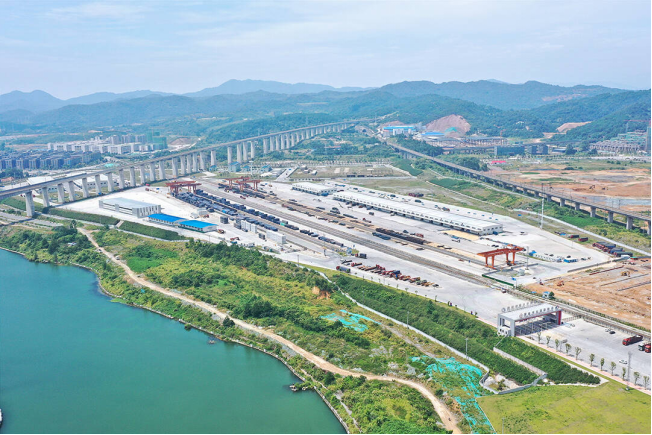
Huaihua is a blessed land for the Chinese revolution. The Chinese Workers’ and Peasants’ Red Army completed troop transfer in Tongdao, Huaihua, marking a turning point in the Chinese revolution. Huaihua is a blessed land for the Chinese nation. After winning the Anti-Japanese War, the Chinese people accepted the surrender of the Japanese invaders in Zhijiang, Huaihua. Huaihua is a blessed land for people all over the world. Yuan Longping, an academician of the Chinese Academy of Engineering, successfully cultivated indica hybrid rice in Anjiang, Huaihua. Huaihua is also a blessed land for merchants. Hongjiang in Huaihua City is historically known as a vital transfer station on the Maritime Silk Road.
Huaihua was born in the 1970s, when the Hunan-Guizhou Railway and Jiaozuo-Liuzhou Railway were launched. Therefore, Huaihua is known as a city on trains. By taking advantage of its position as a transportation hub, Huaihua accelerated the construction of the three-dimensional transportation network incorporating water, land and air transportation and boasting domestic circulation and opening up. In 2017, the city was recognized as a national comprehensive transportation hub.
In the new era, how does Huaihua build itself into a new hub for reform and opening up in the inland region in Hunan Province?
As the central city of the border areas of Hunan, Hubei, Chongqing, Guizhou and Guangxi and a national comprehensive transportation hub, Huaihua has made citywide efforts to accelerate the construction of Huaihua International Land Port, so as to develop the land port into an important strategic platform for central China to contribute to RCEP and engage with ASEAN as well as a landmark project for the reform and opening up in the inland region. The city has formed a new model of opening up that relies on the new western land-sea corridor and the great international land-sea trade corridor, connects the Pacific Ocean and the Indian Ocean, and serves domestic and international economic flows.
As Huaihua International Land Port gains great momentum, Huaihua, a mountain city, seeks ocean-oriented development
According to the Huaihua Sea Voyage Map, Huaihua is the only intersection of the new western land-sea corridor and the great international land-sea trade corridor that connects the Indian Ocean in central China. Boasting prominent regional transportation advantages, the city has offered easy access from all directions since ancient times.
The three-dimensional transportation network incorporates road, railway, water and air transportation. It consists of four ordinary railways, three high-speed railways, eight expressways, a snowflake-shaped water transportation network, and Huaihua Zhijiang Airport. With such transportation advantages, the city has been recognized as a national comprehensive transportation hub and a national logistics hub for commercial services. It has formed a transportation landscape with smooth internal and external connection and linking rivers and seas.
In September 2021, the construction of Huaihua International Land Port officially kicked off. Brimming with momentum, trains starting from the land port made maiden trips on various routes.
In May 2022, the People’s Government of Hunan Province issued the Implementation Plan on Deep Integration into the Belt and Road Initiative to Support the Development of Huaihua International Land Port. The implementation plan gives Huaihua a new positioning and a new mission of “developing itself into a gateway city for building the new western land-sea corridor” and the only ASEAN freight assembly center in Hunan Province and proposed to develop Huaihua International Land Port into a landmark project for Hunan to build a hub for reform and opening up in the inland region.
In July 2022, CPC Huaihua Municipal Committee convened the Third Plenary Session of the Sixth Party Committee, determining to make citywide efforts to expedite the development of Huaihua International Land Port.
On July 22, 2022, Huaihua attended the Inter-provincial Joint Conference of the New Western Land-sea Corridor held in Chongqing for the first time, thereby becoming part of its mechanism.
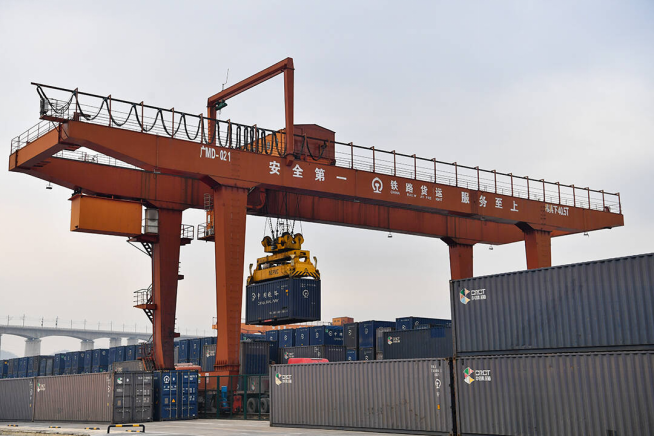
Huaihua International Land Port has continuously improved its facilities and customs clearance services, basically ensuring smooth flow of goods. The port area can handle 400 TEUs each day, with an annual cargo throughout of six million tons.
To ensure the smooth operation of international freight trains, Huaihua Customs has earnestly implemented the key measures of the General Administration of Customs to support the development of the new western land-sea corridor. It has consolidated the collaboration mechanism with primary-level customs authorities along the western land-sea corridor such as Mengla Customs, Pingxiang Customs and Qinzhou Port Customs, so as to unify customs clearance procedures. It has taken solid steps to develop and strengthen smart customs and implemented reform measures such as “advance declaration and direct loading and delivery”. It has proactively promoted efficient models such as “railway fast customs clearance”, with 700 fast customs clearance applications accepted from January to September. It has also opened green channels for the import and export of agricultural products and launched the “7×24” customs clearance appointment service, to ensure smooth train services on holidays.
Wang Youhua, Director of Huaihua Customs, said that Huaihua International Land Port can achieve efficient customs clearance, declaration and inspection. One-stop customs clearance services have improved customs clearance efficiency and facilitated the high-quality development of Huaihua International Land Port. The city will build itself into an ASEAN freight assembly center in Hunan Province, develop the land port into a landmark project for the reform and opening up in the inland region, and further integrate into the construction of the new western land-sea corridor.
With Huaihua International Land Port as the hub, multiple cross-border freight trains, freight trucks and domestic freight trains have been launched. Compared with traditional transportation routes and means, cross-border transportation starting from Huaihua International Land Port boasts a shorter distance and faster delivery.
So far, Huaihua International Land Port has launched seven international logistics channels, including sea shipping channels connecting Huaihua with Beibu Gulf Port, Zhanjiang Port, Guangzhou Port and Shenzhen Port and the China-Laos, China-Vietnam and China-Myanmar cross-border channels. 70% of goods from the new western land-sea corridor are transported southward by way of Huaihua, an important node city on the eastern line of the new western land-sea corridor. The city is forming a new model of opening up that relies on the new western land-sea corridor and the great international land-sea trade corridor, connects the Pacific Ocean and the Indian Ocean, and serves domestic and international economic flows.
As China-Laos Railway service speeds up, Huaihua International Land Port wins the first place in central China in terms of the number of trips made
In the main area of Huaihua International Land Port, international trains loaded with Jiangxi vehicles, Hubei chemical products and Hunan agricultural machinery and steel are heading to ASEAN countries. They have driven the industrial development of areas along the line in Hunan, Hubei and Jiangxi. Thanks to the land port, bags, bamboo products, rice noodles, sugar oranges, tea, wormwood products and other Huaihua products are exported to other parts of the world.
Thanks to the international railway lines, ore from Africa and Australia, tapioca, grain, fruit and other agricultural and forestry products from ASEAN countries are transported to Huaihua and distributed throughout the country. The land port witnesses booming import and export trade.
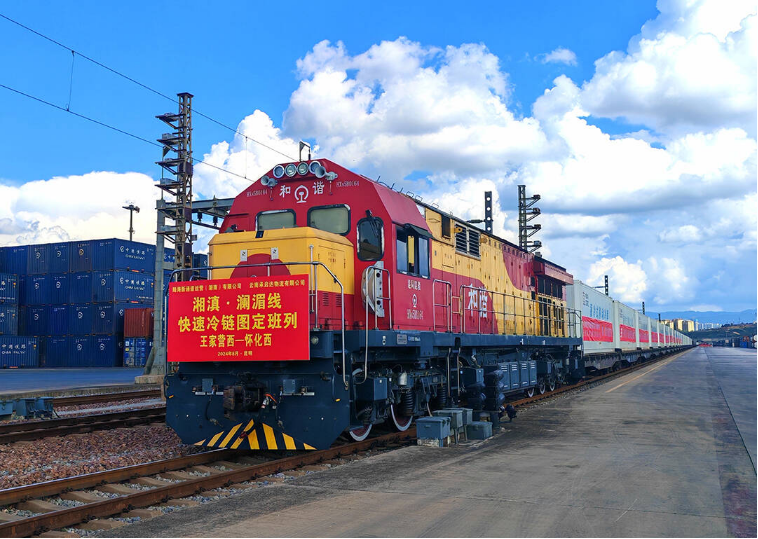
From April 1, 2024, routine China-Laos trains starting from Huaihua International Land Port have increased their trips again, from one trip to three trips per week, remarkably enhancing the export transportation capacity of the China-Laos line.
According to Huaihua Customs (under the jurisdiction of Changsha Customs), Huaihua International Land Port handled 731 trips in the first three quarters of this year, a year-on-year increase of 129.8%. The land port continued to rank first in central China in terms of the number of trips running on the China-Laos Railway, with 261 trips made, a year-on-year increase of 574.7%.
In the first three quarters of this year, Huaihua’s total imports and exports reached RMB10 billion, a year-on-year increase of 65.2%, and its growth rate continued to rank first in Hunan Province. Specifically, exports amounted to RMB8.76 billion, a year-on-year increase of 61.3%; imports amounted to RMB1.24 billion, a year-on-year increase of 98.5%; and exports to ASEAN surged 55.3% from a year ago to RMB2.19 billion.
Internationally, Huaihua International Land Port has actively expanded its sea shipping channels. Its international freight network covers 97 ports and stations in 40 countries and regions around the world. The land port has adjusted the structure of imports and exports, with 221 items in 16 categories covered. The export volume of the “new trio”, including new energy vehicles and photovoltaic products, has steadily increased. Currently, exports are dominated by high value-added products such as compact excavators, paddy pounders, sachets, electric motors, auto parts, motorcycle parts, machine parts, textiles, hardware and daily necessities.
Domestically, Huaihua has actively integrated into the Yangtze River Delta, the Greater Bay Area, city clusters in central China, Chengdu-Chongqing economic zone, and Hainan Free Trade Zone. It has established a cooperation mechanism involving Hunan, Chongqing, Guizhou, Guangxi and Yunnan and facilitated the Hunan-Hubei-Jiangxi cooperation agreement. It has conducted on-site goods supply surveys in Wuhan, Yichang, Jingzhou and Jingmen in Hubei Province and Nanchang and Yingtan in Jiangxi Province to gain a deeper insight into local goods collection and transportation routes, take improvement measures, and step up collaboration to facilitate customs clearance.
As the port industry grows with the “acceleration button” on, integrated development of port, industry and city is advanced
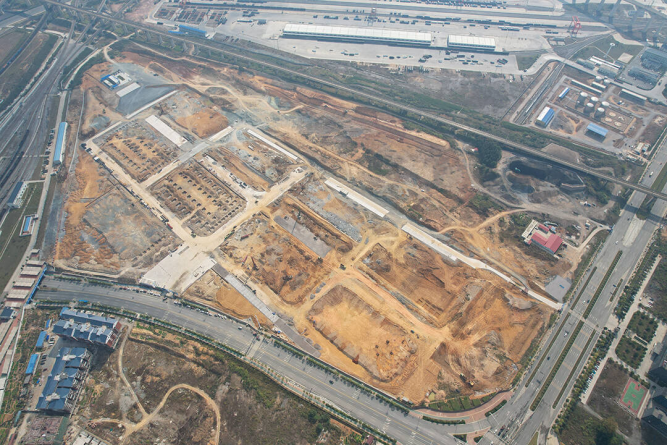
In the Huaihua International Land Port Economic Development Zone, construction of major projects is in full swing. At the project site of the Multimodal Transport Center of Huaihua International Land Port, large construction vehicles shuttle back and forth. China Construction Third Engineering Bureau is developing the infrastructure. The earthwork and foundation treatment work have basically completed; the construction of water supply and drainage pipe networks and roads is halfway done; and the pile foundation construction is underway. Taking advantage of the fine winter weather, workers schedule their work wisely and prepare for the main construction.
The Multimodal Transport Center of Huaihua International Land Port has a total investment of RMB1.02 billion and covers an area of 539 mu (35.93 hectares). The project involves the construction of special railway lines, supporting facilities such as the smart warehousing logistics center and LCL center, as well as the customs supervision area and comprehensive cross-border e-commerce pilot zone. Featuring provincial transportation, regional distribution and urban-rural delivery, the center will develop a complete logistics pattern involving express delivery, FTL shipping, LTL shipping, highway-railway intermodal transport and sea-rail intermodal transport. The center will also collaborate with the Huaihuaxi Railway Logistics Park to achieve differentiated development, facilitate cost reduction and efficiency improvement in logistics, and contribute to building Huaihua into a national logistics hub for commercial services and a logistics-friendly city.
At the bag & suitcase processing and production base of Hunan Xianghuai, modern production lines are neatly arranged, and the machines run with great roars. Workers skillfully operate various equipment on the assembly lines, such as automated injection molding machines and wire-stitching machines, implementing the cutting, sewing and packaging processes in an orderly manner.
“Huaihua has great prospects for developing itself into an ‘international city of bag & suitcase’.” Two years ago, Mou Xiaofeng signed a contract with the People’s Government of Huitong. He founded Hunan Xiangtong Industry Co., Ltd., with a total investment of RMB500 million and an annual output of six million bags. Now, Mou has invested another RMB100 million in the Xianghuai bag & suitcase project, which is expected to produce five million bags and achieve an output value of over RMB600 million per year, create more than 800 jobs, and bring the bag & suitcase industry in Huaihua to a new level.
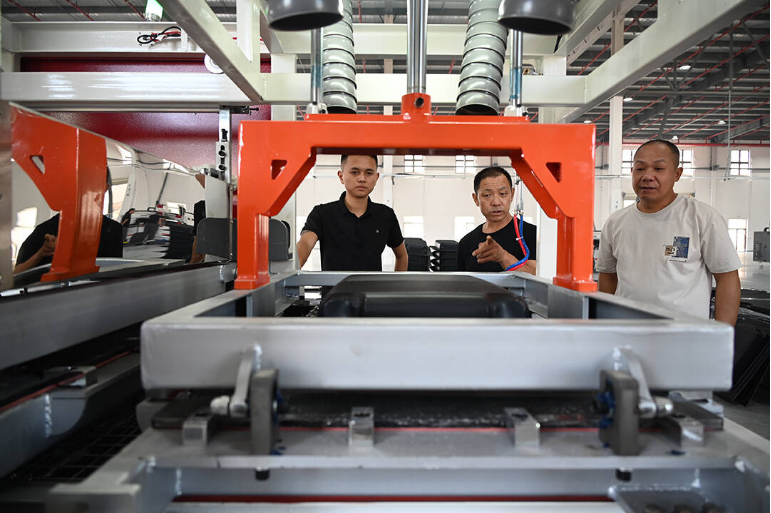
Huaihua has made every effort to build itself into an “international city of bag & suitcase”, an important program in the integrated development of port, industry and city. CPC Huaihua Municipal Committee has incorporated the bag & leatherware industry into the “5+10” modern industrial system and made plans to facilitate its development. Huaihua thereby becomes the first city in the country to build a municipal bag & leatherware production base.
The bag & leatherware industry has grown from scratch in just one year, with 102 industrial projects introduced, with an investment of over RMB8.1 billion. A development pattern has basically shaped, spanning the entire industrial chain, from finished products and auxiliary products to foreign trade and e-commerce. The city strives to foster 300 enterprises in the bag & leatherware industrial chain and 60 enterprises above the designated size and achieve an output value of over RMB10 billion by 2027.
Huaihua has seized the historic opportunities for development. It has gone all out to develop the “5+10” modern industrial system. The new display, bag & leatherware, TCM and other provincial industrial clusters have gained great momentum. A number of leading enterprises in industrial chains with a scale of over RMB1 billion or RMB10 billion are rising quickly. Acting on the principle of “invigorating industries through port development and invigorating the city through industrial development”, Huaihua has been active in promoting the development of the port industry. It gives priority to the bag & suitcase industrial park, green food industrial park and Sannong Industrial Park of China Co-op Group, strives to develop a port industry with a scale of over RMB100 billion, and boosts the integrated development of Hecheng District and Zhongfang County, to better facilitate the development of Huaihua International Land Port. By 2026, Huaihua will strive to increase the number of trips made to over 1,000, increase the cargo throughput to over 10 million tons, and reach a total output value of over RMB100 billion.
(Translated by Professor Yu Jie)
